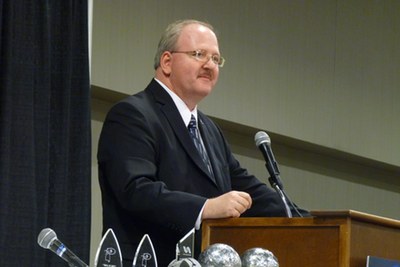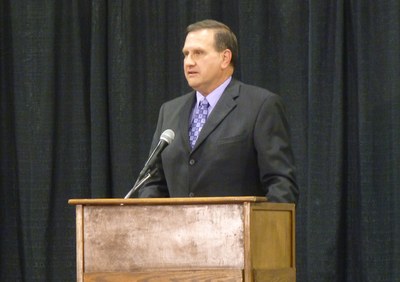New strategies for exploration and settlementby Jeff Foust
|
| “If you want humanity to survive, you’re going to have to create multiple reservoirs of human culture,” Spudis said, “and the way to do that is to expand human civilization off the planet.” |
Spudis took issue with those who he believes have conflated exploration with science. “I think we’ve come in the last century to misunderstand the original meaning of exploration,” he said. Exploration enables science, he said, by making discoveries scientists then attempt to explain, but exploration is more than just science. “Fundamentally exploration is more important than science because it is broader and richer than science,” he said. “It includes both asset protection and wealth generation.”
That approach to exploration, he argued, should be applied to future human space exploration. The “ultimate rationale” for human spaceflight is the survival of the species, he said, noting the record of asteroid and comet impacts and the likelihood that eventually another large body will collide with the Earth, with devastating consequences for life on the planet. “If you want humanity to survive, you’re going to have to create multiple reservoirs of human culture,” he said, “and the way to do that is to expand human civilization off the planet.”
Not surprisingly, Spudis believes the place to begin to do that is the Moon. “We’re going to the Moon to learn the skills to live and work productively on another world,” he said. Those skills, he added, can be grouped into three categories: development of a transportation system, the ability to safely live on another world, and developing resources that can be exported for profit—or, as Spudis put it, “arrive, survive, and thrive.”
Spudis and Tony Lavoie of NASA’s Marshall Space Flight Center have developed an architecture for what they believe is an affordable lunar return, using robotic missions to create an infrastructure for a lunar base for future human missions, but also to mine deposits of water ice believed to exist at the lunar poles. Such a system could produce as much as 150 tonnes of water a year for export elsewhere in cislunar space.
But what is the value of that water? Spudis said it can be used to support operations in cislunar space, the region between the Earth and Moon including Earth orbits and the Earth-Moon Lagrange points, an area he argues is of strategic importance, given all the commercial and national security spacecraft there. But access to and utilization of cislunar space is limited by the difficulty of getting out of the Earth’s gravity well, he argued. “As long as we are limited to what we can lift out of the Earth’s gravity well, we will be mass and power limited in space and therefore capability limited.”
| “I don’t think the public is looking for excitement. I think they know how to excite themselves,” he said. “You can go to the circus and you can get excited, and that’s basically what we’ve turned our space program into.” |
Using lunar resources, he said, enables humanity to “break the tyranny of the rocket equation” and do more in space without having to carry everything from Earth. “The goal is to expand human reach beyond low Earth orbit,” he said, defining “reach” as the ability to send people and machines wherever desired to carry out a given mission. “The Moon becomes not only the first goal, the first destination beyond LEO, it becomes an enabling asset,” he said. “It’s no longer just a place where we go and repeat Apollo, or explore and plant a flag. The real object of going to the Moon is to use what the Moon offers to create this new capability.”
That ability to provide capability and return value is essential to long-term exploration, Spudis said, and is far more important that any excitement generated by such exploration. “I don’t think the public is looking for excitement. I think they know how to excite themselves,” he said. “You can go to the circus and you can get excited, and that’s basically what we’ve turned our space program into.”
“We’re going to spend money on space, we might as well spend it on something that gives us something in return.”
 Jeff Greason warns the ISDC audience on May 21 that without a firm strategy for human spaceflight to support settlement, NASA’s human spaceflight program could come to an end. (credit: J. Foust) |
Strategies for space settlement
The following evening at ISDC, Jeff Greason, president of XCOR Aerospace and a member of 2009’s Augustine Committee, examined the issue of space strategy, or notably a lack thereof. A strategy, he explained, is part of an organizational hierarchy: it provides a “big picture approach” to achieving a specific goal; below that are objectives one uses to measure progress on that strategy towards the goal, and tactics to achieve those objectives.
“Strategy is the void that we have right now,” Greason said in his dinner speech. At one end there is a lot of discussion about tactics, such as the choice of launch vehicles that often dominates debates on space policy, he noted. At the other end, he said, there’s a growing realization of what the goal of the national space program is—although many may not realize it.
“We have just started, I think, to realize in the last eight or ten years that we do have a goal for the national space program,” he said. “There is a national consensus among policymakers that we have that goal, but everybody’s kind of afraid to say it, because they’re not sure we can do it.” That goal, he said, is the “s-word”: “It is actually the national policy of the United States that we should settle space.”
| “It is actually the national policy of the United States that we should settle space,” Greason said. |
To support that claim, Greason cited a number of studies and speeches, including the conclusion of the Augustine Committee that “the ultimate goal of human exploration is to chart a path for human expansion in to the solar system.” He also noted President Obama’s speech at the Kennedy Space Center last April included a veiled reference to space settlement: “Our goal is the capacity for people to work and learn and operate and live safely beyond the Earth for extended periods of time, ultimately in ways that are more sustainable and even indefinite.”
What’s missing between the realization of that goal and the ongoing debates about tactics is a coherent strategy to achieve that goal. “Strategy is the void that we have right now,” he said. “We don’t even have the beginnings of a national agreement on what our strategy ought to be. And until we have one, we’re going to continue to flail.”
What is Greason’s idea for a strategy? In the speech, he proposed a “planet hopping” approach analogous to the “island hopping” strategy the US used against Japan in World War Two. “What we have to do is take the planetary destinations in sequence,” he said, referring to the Moon, near Earth objects, the moons of Mars, and Mars itself. “In each one of them, the purpose of the initial human outpost is not to be there and look cool. It is not to unfurl flags and take pretty pictures, and it is not the holy grail of science, although we will get all of those things. It’s to make gas.” That is, each destination will produce propellant that will enable a cost-effective step to the next destination.
“If you do that, a lot of interesting things fall out,” he said. Such an approach would generate demand for propellant in low Earth orbit, enabling lower cost launches (through increased demand for launches to supply that propellant) and propellant depots, and also provide a predictable market for new reusable launch vehicles. That strategy also allows time to build up deep-space experience and finding ways to deal with hazards like radiation before going directly to Mars; Greason likened missions to L1 and near Earth objects to the Gemini missions that built up experience and capabilities for NASA’s early human spaceflight program before the Apollo lunar missions.
Moreover, such a strategy could be affordable within NASA’s current budget. “Let’s face an uncomfortable truth: the national NASA budget is not going up,” he warned, adding that declines were all but inevitable in the years to come as overall federal spending is reduced. “It’s my belief that if we pursued this the right way, we actually could afford to do this, all the way out to the first landings on Mars, for the kind of budget NASA’s getting now,” he said, or possibly even a little less.
NASA’s future in the balance?
In their separate speeches, Greason and Spudis share many key points. Both agree that human settlement of space is perhaps the overarching long-term goal of human spaceflight, and both see the utilization of resources in space as essential to making such an effort sustainable over the long haul. Greason’s approach is arguably a superset of Spudis’s: both include utilizing lunar resources, although Greason looks beyond to asteroids, the moons of Mars, and Mars as well.
| “If we haven’t done better in the next ten years than we have in the last ten years,” Greason warned, “we’re going to lose that fight, and NASA’s human spaceflight activity will end.” |
On one key point they do differ. Spudis sees his vision of making use of lunar resources the best use of NASA’s resources, but not something he stakes the survival of the agency on. “The idea that we would not have a space program is ludicrous,” he said. “We will have one, of one type or another. So the question becomes, what are you going to spend, and what is it going to cost? I contend that doing this [utilizing lunar resources] is returning value to the public.”
Greason, though, is more pessimistic about the future of at least NASA’s human spaceflight program without a firm strategy in place for space settlement. Without that strategy, he said, “we’re going to build a big rocket, and then we’re going to hope a space program shows up to fly it. Any in my opinion, that strategy—the strategy of default—is going to result in the end of the NASA human spaceflight program” when members of Congress question the wisdom of spending several billion dollars a year on that effort and its lack of progress in an era of constricting budgets. “If we haven’t done better in the next ten years than we have in the last ten years, we’re going to lose that fight, and NASA’s human spaceflight activity will end.”
